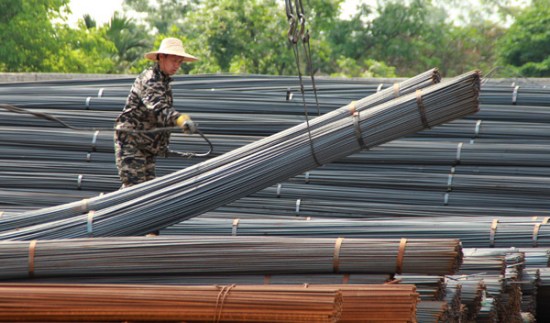
A worker guides the transport of steel products at a market in Haikou, capital of Hainan province. First-quarter steel exports surged 40.7 percent to 25.78 million metric tons as mills responded to weak domestic demand and falling prices. (Photo/China Daily)
First-quarter steel exports surged 40.7 percent to 25.78 million metric tons as mills responded to weak domestic demand and falling prices, the China Iron and Steel Association said on Wednesday.
"Although domestic steel companies face increasing trade disputes in foreign markets, exports will continue to increase, driven by global demand and the companies' price competitiveness," said CISA Vice-President Zhu Jimin.
The jump in exports also reflected a low base of comparison, he said.
Zhu said that overseas sales will grow more slowly this year because the government has ended export rebates for certain steel products.
After rebates were eliminated, steel exports weakened from 10.3 million tons in January to 7.8 million tons in February and again to 7.7 million tons in March, according to CISA data.
Even though demand and prices fell, while environmental protection costs rose, the industry's first-quarter aggregate loss narrowed. Medium-sized and large mills lost a total 987 million yuan ($159.6 million), compared with 8 billion yuan a year earlier, the association said.
The booming stock market offset deficits in steel mills' core business.
"Many steel companies invested in the stock market in recent months, which helped their financial performance," said Chen Yuqian, deputy director of the finance and assets department of the CISA.
He said the companies' steel operations recorded a total loss of 11.05 billion yuan in the first quarter, 3.43 billion yuan more than a year earlier.
Some giant steel companies that own iron ore mines experienced even bigger problems as the prices of the raw materials slumped from $133 a ton at the beginning of 2014 to about $51 a ton late last month.
"Falling iron ore prices have helped Chinese steel mills cut costs for raw materials, but declining prices made some steel giants including Shougang Group and Hebei Iron and Steel Group post huge losses in their mining segment," Zhu said.
In the past, owning mines was a good way to control raw material cost for Chinese steel mills, but now it is a burden because of sharply falling global iron ore prices, he said.
Compared with low-cost iron ore products from Brazil and Australia, China's domestic iron ore has no quality or cost advantage.
China imported 227 million tons of iron ore in the first quarter, up 2.3 percent year-on-year.
Zhu said up to 80 percent of China's iron ore will be imported this year, which is not good for the security of the country's steel industry.
















































